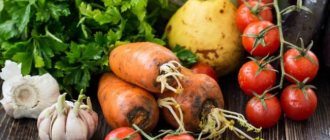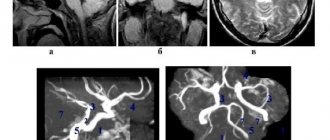Hypercholesterolemia and atherosclerosis
High cholesterol levels in a blood test, otherwise hypercholesterolemia, are the result of a failure of fat metabolism in the body. The key factor of the disorder is unhealthy eating behavior, addiction to fatty and sweet foods against the background of physical inactivity.
Exogenous cholesterol from food accounts for 20% of the total. The rest is synthesized by hepatocytes (working liver cells). Exceeding the norm of fat in the diet leads to the body’s inability to process and properly distribute cholesterol. After absorption into the blood, endogenous and exogenous cholesterol molecules combine with proteins to form lipoproteins:
- low and very low density (LDL and VLDL) – transport cholesterol into cells as a lipid resource;
- high density lipoproteins (HDL) - are responsible for the return delivery of excess low-density lipoproteins to the liver for neutralization and excretion.
An increase in total cholesterol levels is caused by an imbalance of lipoproteins (increased LDL and decreased HDL). Moving through the bloodstream, excess LDL “gets stuck” in microcracks in the intima (the inner layer of the vascular walls). A cholesterol spot forms, transforming over time into a plaque. As intravascular growths increase, normal blood circulation and blood supply to the most important organs are disrupted.
Thus, it develops:
- atherosclerosis of the aorta of the heart and coronary arteries;
- atherosclerosis of blood vessels of the lower extremities;
- atherosclerosis of the carotid arteries of the neck and cerebral vessels of the brain.
The causes of intimal damage are nicotine and alcohol addiction, chronic blood diseases, diseases of the endocrine system, hypertension, hypovitaminosis of vitamins A, C, D, E.
Important! The goals of dietary nutrition are to adjust the balance of lipoproteins, improve hemodynamics (blood movement through the vessels), lower the concentration of cholesterol in the blood, and prevent complications of atherosclerosis.
conclusions
Proper nutrition is an important aspect of treating atherosclerosis. Its principles are simple and painfully familiar to everyone: a minimum of fatty and sweet foods, more natural products. Still, the origins of the human race are lost somewhere in the lap of nature, and not behind the door of the nearest fast food restaurant.
Diet for atherosclerosis – both treatment and prevention. It is in the patient’s interests to make it primary (aimed at preventing the onset of symptoms of the disease) by studying healthy recipes.
Features and types of diet
For vascular atherosclerosis and hypercholesterolemia, the therapeutic diet “Table number 10” is prescribed. It is intended for patients with cardiovascular pathologies in the compensated and subcompensated stage. The food basket is formed according to the principle of “allowed” and “permissible with restrictions.” Harmful products are completely excluded. The food system includes several varieties, united by general rules.
Basic principles of catering:
- Control over daily caloric intake, portion size, nutrient ratio, amount of water consumed.
- Reduce salt (up to 5 g/day), canned pickles, salty foods, sugar, sweets.
- Refusal of food processed by cooking (including over an open fire, charcoal). The diet includes dishes prepared by boiling, stewing, baking in foil, or steaming.
- Introduction to the daily menu of foods rich in fiber, vitamin C, Ω-acids, and phytosterols.
- Compliance with the diet (the interval between meals is 3-4 hours).
- Strict limitation of alcoholic drinks, coffee (complete exclusion of energy drinks and sweet soda).
As an auxiliary therapy for atherosclerosis, it is recommended to include in the diet herbal decoctions of herbs that cleanse blood vessels and stimulate the heart (plantain, dandelion roots, hawthorn, etc.).
Types of diet
| Index | Indications | Nuances |
| 10-A | for chronic diseases of the cardiovascular system with severe impairment of blood flow | reduction in calories and nutrients |
| 10-B | with inflammation of the connective tissue of the myocardium (rheumatism), with moderate impairment of blood flow | increase protein, reduce salt to 3-4 g/day |
| 10-C | for atherosclerosis of the vessels of the lower extremities, atherosclerotic cardiosclerosis, coronal and aortic atherosclerosis, atherosclerosis of the vessels of the brain and the main arteries of the neck | strict limitation of animal fats, salt, increase in fiber |
| 10-P | for inflammation of the connective tissue of the joints (rheumatoid arthritis) | reducing salt to 3 g/day |
| 10-G | for hypertension degrees III and IV | maximum salt limit to 2 g/day |
| 10-I | in the post-infarction and post-stroke period | reduction in calories and portions (in the first two days - only drinking) |
Daily values for diet No. 10-C
It is a mistake to believe that atherosclerosis is typical for people with excess body weight. Elevated cholesterol levels, as a cause of the disease, are often found in people who smoke, have a slender build, and abuse animal fats and alcohol. Dietary guidelines for calories and nutrients are based on BMI (body mass index).
Help: BMI is calculated using the formula weight in kg divided by height in m2.
To effectively reduce body weight and accelerate blood flow, it is recommended to combine the diet with feasible physical activity (physical therapy group exercises, swimming, Nordic walking, gymnastics, Pilates, yoga).
About drinks
In order not to create additional stress on the blood vessels of the brain and heart, you should stop drinking coffee. Sweet soda should be completely excluded from the diet. Healthy drinks include:
- compote of fresh or frozen berries;
- fruit compote or jelly (no added sugar);
- green tea with mint;
- fresh vegetable;
- decoction of rosehip, burdock and dandelion roots;
- ginger-citrus drink.
Advice! To prepare a ginger-citrus drink, you need to cut 1 orange and 1 lemon, brew with boiling water, leave for a quarter of an hour, add grated ginger root. You can drink at any time of the day. The drink has a powerful antioxidant effect, helps lower cholesterol, strengthens the immune system, and promotes weight loss.
List of products prohibited for atherosclerosis
Based on the fact that cholesterol is a derivative of animal lipids, it is necessary to eliminate fatty foods from the diet. Fast carbohydrates and pickles are subject to complete and partial exclusion.
Products by category
| meat | poultry (duck, goose), pork, lamb |
| fish | preserves, caviar, salted and dried fish |
| smoked products | deli meats, fish, lard, sausage |
| sausages | sausages, wieners, boiled sausage, bacon |
| sauces | ketchup, mustard, mayonnaise and mayonnaise-based sauces |
| conservation | stewed meat, condensed milk, canned fish, pates (meat, sprat), salted, pickled mushrooms and vegetables, sweet fruits in their own juice |
| sweets | milk chocolate, ice cream, desserts with butter cream, glazed curd cheeses |
| bakery | white bread, confectionery and pies made from choux pastry, butter pastry, puff pastry and shortbread pastry |
| semi-finished products (store-bought) | dumplings, khinkali, pasties |
| cheese | durum varieties with fat content ≥40% |
| beverages | bottled tea, packaged juices, brewed coffee, sweet soda, energy drinks |
| milk products | sour cream ≥ 15%, fermented baked milk, milk, yogurt, kefir ≥2.5% |
| offal | liver, kidneys, brains |
The menu should not include the following dishes: meat broths from pork, duck, lamb, chicken with skin, scrambled eggs, pancakes, pancakes, fast food. It is prohibited to use flavored snacks and crackers, chips, or popcorn as a snack.
Information: Not long ago, eggs were excluded from the list of foods harmful to atherosclerosis. Studies have proven the content of polyunsaturated fatty acids in them - arachidonic, linoleic, linolenic and Ω-acids, which help eliminate LDL and reduce total cholesterol levels. Boiled chicken and quail eggs have been transferred to the list of limited products.
Fully or partially limited products
Products made from puff pastry and butter dough, meat, fish, and mushroom broths are completely excluded. You cannot eat fatty pork, cooking fats, duck, goose, kidneys, brains, liver, sausages, canned food and all kinds of smoked meats.
Fatty fish, canned fish and caviar, salted and smoked fish are prohibited. Do not eat fatty cheese and cream, cottage cheese and sour cream. The consumption of radishes, radishes, sorrel, spinach and mushrooms is prohibited. Chocolate, ice cream, and products with cream are not allowed. As for sauces, you should not use meat, fish, mushroom, or mustard. Strong tea and coffee, cocoa are prohibited.
Limit egg yolks, rice, semolina and pasta, mayonnaise, horseradish. For obesity - grapes, sugar, honey, raisins, jam are allowed rarely and in minimal quantities.
Table of prohibited products
| Proteins, g | Fats, g | Carbohydrates, g | Calories, kcal | |
Vegetables and greens | ||||
| radish | 1,2 | 0,1 | 3,4 | 19 |
| white radish | 1,4 | 0,0 | 4,1 | 21 |
| red radish | 1,2 | 0,1 | 3,4 | 20 |
| black radish | 1,9 | 0,2 | 6,7 | 35 |
| spinach | 2,9 | 0,3 | 2,0 | 22 |
| sorrel | 1,5 | 0,3 | 2,9 | 19 |
Fruits | ||||
| bananas | 1,5 | 0,2 | 21,8 | 95 |
Berries | ||||
| grape | 0,6 | 0,2 | 16,8 | 65 |
Mushrooms | ||||
| mushrooms | 3,5 | 2,0 | 2,5 | 30 |
Nuts and dried fruits | ||||
| raisin | 2,9 | 0,6 | 66,0 | 264 |
Cereals and porridges | ||||
| semolina | 10,3 | 1,0 | 73,3 | 328 |
| rice | 6,7 | 0,7 | 78,9 | 344 |
Flour and pasta | ||||
| pasta | 10,4 | 1,1 | 69,7 | 337 |
Confectionery | ||||
| jam | 0,3 | 0,2 | 63,0 | 263 |
| jam | 0,3 | 0,1 | 56,0 | 238 |
| candies | 4,3 | 19,8 | 67,5 | 453 |
| pastry cream | 0,2 | 26,0 | 16,5 | 300 |
| cookie | 7,5 | 11,8 | 74,9 | 417 |
Ice cream | ||||
| ice cream | 3,7 | 6,9 | 22,1 | 189 |
Cakes | ||||
| cake | 4,4 | 23,4 | 45,2 | 407 |
Chocolate | ||||
| chocolate | 5,4 | 35,3 | 56,5 | 544 |
Raw materials and seasonings | ||||
| mustard | 5,7 | 6,4 | 22,0 | 162 |
| mayonnaise | 2,4 | 67,0 | 3,9 | 627 |
Dairy | ||||
| milk 3.6% | 2,8 | 3,6 | 4,7 | 62 |
| milk 4.5% | 3,1 | 4,5 | 4,7 | 72 |
| cream | 2,8 | 20,0 | 3,7 | 205 |
| sour cream 25% (classic) | 2,6 | 25,0 | 2,5 | 248 |
Cheeses and cottage cheese | ||||
| cheese | 24,1 | 29,5 | 0,3 | 363 |
| cottage cheese 11% | 16,0 | 11,0 | 1,0 | 170 |
| cottage cheese 18% (fat) | 14,0 | 18,0 | 2,8 | 232 |
Meat products | ||||
| pork | 16,0 | 21,6 | 0,0 | 259 |
| pork liver | 18,8 | 3,6 | 0,0 | 108 |
| pork kidneys | 13,0 | 3,1 | 0,0 | 80 |
| pork fat | 1,4 | 92,8 | 0,0 | 841 |
| salo | 2,4 | 89,0 | 0,0 | 797 |
| beef liver | 17,4 | 3,1 | 0,0 | 98 |
| beef kidneys | 12,5 | 1,8 | 0,0 | 66 |
| beef brains | 9,5 | 9,5 | 0,0 | 124 |
Sausages | ||||
| smoked sausage | 16,2 | 44,6 | 0,0 | 466 |
| smoked sausage | 9,9 | 63,2 | 0,3 | 608 |
| sausages | 10,1 | 31,6 | 1,9 | 332 |
| sausages | 12,3 | 25,3 | 0,0 | 277 |
Bird | ||||
| smoked chicken | 27,5 | 8,2 | 0,0 | 184 |
| duck | 16,5 | 61,2 | 0,0 | 346 |
| smoked duck | 19,0 | 28,4 | 0,0 | 337 |
| goose | 16,1 | 33,3 | 0,0 | 364 |
Fish and seafood | ||||
| smoked fish | 26,8 | 9,9 | 0,0 | 196 |
| salted fish | 19,2 | 2,0 | 0,0 | 190 |
| Red caviar | 32,0 | 15,0 | 0,0 | 263 |
| black caviar | 28,0 | 9,7 | 0,0 | 203 |
| canned fish | 17,5 | 2,0 | 0,0 | 88 |
| cod (liver in oil) | 4,2 | 65,7 | 1,2 | 613 |
Oils and fats | ||||
| animal fat | 0,0 | 99,7 | 0,0 | 897 |
| cooking fat | 0,0 | 99,7 | 0,0 | 897 |
Non-alcoholic drinks | ||||
| instant coffee dry | 15,0 | 3,5 | 0,0 | 94 |
| black tea | 20,0 | 5,1 | 6,9 | 152 |
| * data is per 100 g of product | ||||
Products subject to restrictions
It is impossible to completely exclude products containing animal fats from the diet even with atherosclerotic changes in blood vessels. Cholesterol is a lipophilic alcohol localized in cell membranes and protects cells. Without cholesterol, the following processes are impossible:
- production of sex and steroid hormones, bile acids;
- maintaining interneuronal connections of the brain and spinal cord;
- food fermentation;
- carrying a pregnancy.
Cholesterol is a conductor for the complete absorption of fat-soluble vitamins A, E, and D by the body.
Patients with atherosclerosis and high cholesterol in the blood are allowed to consume fatty fish (sturgeon, halibut, capelin, mackerel) once a week as a source of Ω-acids, chicken eggs (1-2 pcs.), quail eggs (5-10 pcs.) , soy sauce and teriyaki sauce, pita bread, unleavened flatbread. Butter is allowed 5-10 g/day.
Patients with atherosclerosis with a high body mass index should limit the following foods:
- marshmallows, marmalade, honey;
- nuts, seeds;
- sour cream 10%;
- pasta, vermicelli, etc. Pasta must be made from the highest varieties of wheat (category “A”, gluten-free).
Vegetable oils do not contain cholesterol, but, as a high-calorie product, they can be consumed in small quantities. Oils with a high content of fatty acids are recommended. The leaders are considered to be flaxseed, olive (cold pressed), and grape seed oil. The refusal to eat pork does not apply to lightly salted lard. It contains arachidonic acid, which lowers LDL and total cholesterol. At the same time, the concentration of HDL increases compensatoryly. The daily dose of the product is 10 g.
Nutritionist's recommendations
- The main diet should consist of high-density lipoproteins with a sufficient amount of digestible vitamins.
- Food is cooked mainly by steaming without the use of fat. Vegetable oil is used for dressing salads and other dishes.
- When cooking broth from lean meat, the cooled fat is skimmed off the surface.
- Fried foods, as well as canned foods and pickles, including home-made and factory-made canned meat and fish, are completely excluded.
- Smoked products are prohibited.
- There is no need to add salt during the cooking process. Table salt is used in small quantities when serving the dish.
- For home baking, use chicken protein, not yolk.
- The daily diet is five meals a day. This technique allows you to avoid overeating and minimize the feeling of hunger between meals.
Find out the causes of excess weight and ways to quickly lose weight
Sign up for a free initial appointment with a nutritionist!
The daily menu of a patient with atherosclerosis consists mainly of protein foods:
- lean meat;
- low-fat cottage cheese;
- fish.
Important! The volume of each of the above products is about 150 grams (daily).
What do protein-rich foods do?
With their help, you can create a long-lasting feeling of fullness. The human body takes longer to process such products. Therefore, repeated meals after a short period of time are not required.
Plant sterols in the diet of patients with atherosclerosis
Sterols are components that are contained in:
- in natural vegetable oils;
- in nuts;
- in legumes;
- in cereals.
Thanks to sterols, excess cholesterol is not absorbed into the bloodstream. Thus, foods high in sterols become part of a comprehensive program for the management of patients with vascular atherosclerosis. The daily norm of sterols is about two grams.
Permitted and required products
The basis of therapeutic nutrition for atherosclerosis is foods rich in antioxidants, fatty acids, and fiber. The source of animal protein is lean meats, fish, and seafood. The body receives plant protein from legumes, cereals, and nuts.
To balance carbohydrates, preserve intestinal microflora, maintain liver function and lose weight, low-fat dairy and fermented milk products are included in the diet. Forbidden hard cheeses are replaced with low-fat varieties: tofu (1.5-4%), gaudette (7%), chechil (5-10%), ricotta (13%).
List of allowed, limited and prohibited products for atherosclerosis
Any vegetables, berries and fruits are allowed for atherosclerosis. To reduce cholesterol levels, it is preferable to choose the following foods:
- white and cauliflower, broccoli;
- Bell pepper;
- citrus fruit;
- sour berries with a high content of ascorbic acid (cranberries, viburnum, lingonberries, currants).
A useful addition to dishes is bran, which contains phytosterol, a plant analogue of cholesterol. The substance helps restore the balance of LDL and LDL, cleanse blood vessels, remove excess bile acids and cholesterol, and reduce weight.
Products by category
| meat | chicken (without skin), turkey, rabbit (fillet) |
| fish with a fat content of 8-15% | pollock, navaga, tuna, cod, whiting, pike, |
| seafood | mussels, squid, seaweed |
| legumes | beans (regular and green), peas, lentils, chickpeas |
| flour products | rye bread, wheat-rye bread, whole grain bread |
| grains and cereals | buckwheat, rice, oats, pearl barley |
| dairy | kefir, fermented baked milk, yogurt ≤ 2.5%, acidophilus ≤ 3.2%, cottage cheese ≤ 5%; |
| sweets | berry, fruit jelly |
The menu should be enriched with products useful for hypercholesterolemia:
- spinach, green peas - contain lutein, which inhibits the action of free radicals;
- carrots, sea buckthorn - rich in carotenoids, which protect cells from damage and strengthen the immune system;
- green tea, blueberries, blackberries, black currants - contain polyphenols that stimulate cardiac activity, prevent the formation of blood clots, and lower cholesterol levels.
Any greens, onions (onions and greens), and garlic are recommended for daily consumption. The benefits of garlic for lowering cholesterol, cleansing blood vessels and reducing atherosclerotic plaques are recognized by official medicine.
Advantages and disadvantages
| pros | Minuses |
|
|
Meal options for high cholesterol and atherosclerosis
Having decided on the permitted products and excluding prohibited dishes, you can begin to develop a personal nutrition system. For ease of use, the menu is best prepared for the week.
Breakfasts and first courses for lunch for 7 days
| Morning meal | Soups |
| steam omelette with herbs and tomatoes | cabbage soup in chicken broth |
| cheesecakes baked in the oven | chicken broth with chicken fillet meatballs |
| lazy dumplings with cottage cheese | ear |
| rice porridge with milk 2.5% | bean soup with chicken broth |
| oatmeal (with water or milk) | rice soup with tomatoes |
| boiled egg + black bread with tofu cheese | gazpacho |
| barley porridge | cold borscht or okroshka |
For taste, you can add dried fruits and fresh berries to the porridge.
Salads and snacks for the week
| Salads | Lunch | Afternoon snack |
| the vinaigrette | fresh fruits | yogurt |
| vegetable made from tomatoes, cucumbers and fresh herbs | berry mousse, | vegetable puree |
| vitamin from cabbage, carrots and sweet peppers | fruit puree | cottage cheese with yogurt |
| “Greek” (replace fetax with ricotta or tofu) | forest and garden berries with milk 2.5% | cottage cheese casserole with raisins |
| beets with garlic | oven baked apples | grain curd (finished product) |
| seaweed with cucumbers, corn and onions | marshmallows, muesli | Ryazhenka with unsweetened cookies "Maria" |
| Chinese cabbage with cucumbers and herbs | fruit salad | Ricotta cheese, biscuits |
For salad dressing, you can use vegetable oil with lemon juice, natural yogurt with lemon juice. Occasionally it is allowed to season the salad with low-fat sour cream (10%).
Dinners and main courses
| Main dishes | Side dishes | Set meals |
| turkey baked in foil with tomatoes | rice with vegetables | cabbage stewed with rabbit |
| rabbit fillet goulash | crumbly buckwheat or pearl barley porridge | vegetable stew with chicken |
| fish baked in foil with herbs and lemon | mashed potatoes | pilaf with turkey |
| boiled chicken | steamed broccoli | potato casserole |
| steamed meatballs, cutlets, chicken or turkey meatballs | boiled potatoes | baked zucchini and eggplant with tomatoes |
1-1.5 hours before bedtime, it is recommended to drink a glass of low-fat fermented milk drink (kefir, yogurt).
Reviews and results
This diet is designed to last for a long time, as it is balanced and contains a variety of foods. Some restriction in carbohydrates and fats does not adversely affect health, but on the contrary allows you to lose weight, normalize cholesterol and feel good. All these points are noted in the reviews of patients.
- “...I improved my health and lost weight. I liked this healthy diet. True, I was also prescribed pills to lower cholesterol”;
- “... I’m happy with the results: cholesterol has decreased, sugar has normalized, and I’ve even lost weight. Beauty!";
- “...Cholesterol was not very high, so I managed only with therapeutic nutrition. I continue to eat like this”;
- “... My result is minus 5 kg, my general condition has improved significantly and my tests have become normal”;
- “... Helped me lose weight and improve my condition, but I think that the tests became normal thanks to the pills. I won’t push myself further and will eat right.”
- “... This is not even a diet, but proper nutrition. I see only benefits in low-fat dishes without frying or batter. I eat constantly, even though no one prescribed it for me. Cholesterol is normal."
Results
Nutrition for atherosclerosis of the vessels of the brain, lower extremities, neck and heart is organized according to the rules of the therapeutic diet “Table No. 10-C”. The diet is based on the consumption of:
- safe (low-fat) protein products;
- vegetables, herbs and fruits rich in fiber;
- complex carbohydrates, which allow you to maintain a feeling of fullness for a long time;
- low fat dairy products.
The purpose of the nutritional system is to reduce blood cholesterol, improve blood circulation, and prevent complications.
Classification of the disease
The formation of atherosclerotic plaques can occur in individual vessels or affect most of them. Depending on the organ in which blood flow is reduced and the affected artery, the following forms of the disease are distinguished:
- Heart shape. Ischemic atherosclerosis with damage to coronary vessels and valves.
- Kidney form. The renal arteries are affected.
- Brain (cerebral) form. The disease spreads to intracranial vessels.
- Intestinal form. The mesenteric arteries are affected.
- Atherosclerosis of the aorta. Its abdominal region is most often affected.
- Atherosclerosis of the arteries of the lower extremities, mainly femoral.
- Atherosclerosis of brachiocephalic vessels. These include the right carotid, vertebral and subclavian arteries.










